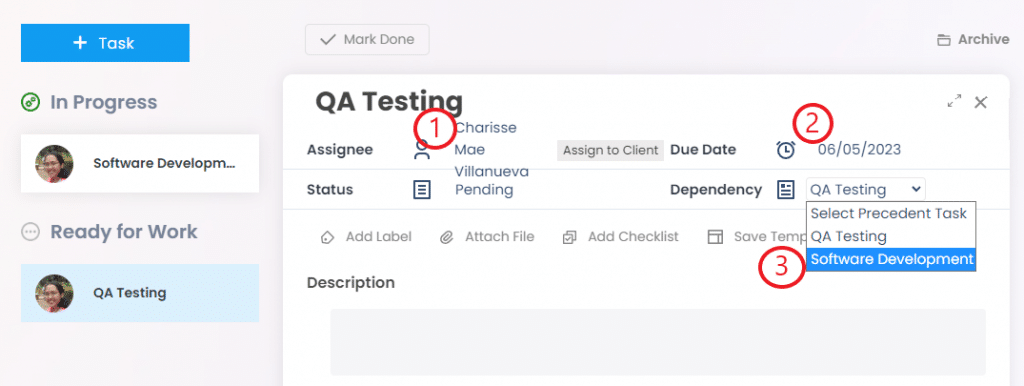In many projects, especially in remote work and SMB settings, task dependencies are nearly impossible to avoid due to interconnected priorities that tend to occur as the project’s complexity grows. With this in mind, project management tools can be a godsend in managing these dependencies.
According to Monday, keeping an eye on dependencies is crucial because they tend to create bottlenecks. And bottlenecks mean waiting on other people to finish their work, which can lead to delays and opportunity costs.
What are Task Dependencies?
Task dependencies can be defined as the task order relationships established within a project. They’re like dominos- one must fall first to make the next one move.
In a typical project, some tasks need to wrap up before any other priorities within the task list could be started. For this reason, dependencies are defined and managed to clarify the task management strategies, ensuring both predecessor and successor tasks would meet pre-defined start or finish dates.
There are also relationships called external dependencies, which refer to tasks or activities that depend on factors outside the team or project. These are elements of a project that are typically outside of the project manager’s control.
A competent project manager needs to be knowledgeable in task management and risk prevention across all dependency types. They need a good grasp of project requirements in order to identify which tasks are dependent and must be finished first.
The Importance of Managing Task Dependencies in Project Management
When established properly, dependency relationships can promote efficient roadmap implementation by clarifying critical paths and priorities for project managers and stakeholders.
Effectively managing dependencies can optimize both resource and team delegation, avoiding delays and ensuring complex projects stay organized. It encourages thorough project planning and resource allocation to complete projects within optimal time and budget.
Mismanaged dependencies can impact timelines and budgets and even pose security risks. Therefore, understanding and efficiently managing these dependencies is crucial for completing a project.
In addition, they also highlight that multiple tasks might share one or more dependencies which prevent overlaps, further emphasizing the importance of effective dependency management.
Types of Task Dependencies
In our comprehensive task dependencies list, we discovered four types of dependencies usually encountered when managing complex and large-scale projects, each playing a unique role and influencing different facets of your project management.
Finish-to-Start (FS)
Finish to Finish is the simplest and most common among the four types of task dependencies. Teams and stakeholders should complete forefront priorities before starting the next one (the domino example). You find it in various projects, from software development to event planning. It ensures smooth and logical progress.
For instance, a programmer needs to finish writing code before the tester can start testing it. In this example, the QA testing process needs to wait for the predecessor task it’s dependent on (coding) before kicking off.

Here is an example of how to implement the Finish-to-Start dependency on Ahsuite.
- Assign the successor task to a member.
- Set the deadline.
- Select the predecessor task in the dependency section.
- Upon saving, QA Testing would be moved from “Ready for Work” to “Pending.”
Take note: The first task must already be in progress. The successor task (QA Testing) cannot start when Software Development is still ongoing.
Start-to-Start (SS)
Start to Start suggests that two tasks can kick off simultaneously, but the predecessor task must start first before the successor task can start. This type of dependency often applies to tasks that must start together for the project’s next phases to continue without delay.
You can see this dependency type in the video production process where filming (Task A), and behind-the-scenes documentation (Task B) start together.
Finish-to-Finish (FF)
A little more intricate, Finish to Start indicates two tasks running concurrently, but the second can only wrap up once the first is done. It’s often seen in tasks that share resources, where completing both rely on the maximum use of those resources.
It’s like running a race where both runners start simultaneously, but runner B can only cross the finish line once runner A does. This dependency focuses on strengthening alignment with completion requirements.
Start-to-Finish (SF)
Start to Finish is considered the most complex and debated one, most projects avoid this dependency. Here, the second task can only end once the first task has started. It’s seldom used but can be applicable in scenarios where a handover of responsibilities occurs, ensuring no gap in operations.
For example, an old software system (Task B) needs to stay operational until a new system (Task A) starts to ensure continuous service.
What is the Most Common Type of Task Dependency?
The Finish-to-Start (FS) dependency is the most commonly used dependency by PM professionals on a wide variety of projects. The successor task cannot start until the predecessor task is complete, creating a straightforward “cause and effect” relationship.
Tasks like writing a report before reviewing it or baking a cake before decorating highlight this dependency. It ensures tasks progress logically and smoothly, making it the go-to task dependency for professionals who aim to effectively estimate project duration, implement optimal task order, and ensure efficient project scheduling.
Identifying and Establishing Task Dependencies
Understanding dependencies is a critical aspect of successful project management. It ensures smooth execution and timely completion of projects. Here’s a step-by-step guide on how to identify and establish these dependencies:
- Break Down the Project – Start by deconstructing the overall project into manageable, individual tasks. This allows for better understanding and assessment of the project scope and helps in determining the sequence and dependencies of tasks.
- Evaluate Activities – Conduct an in-depth analysis of each identified procedure. Determine if the successful completion or initiation of an activity relies on the conclusion or start of another one.
- Identify Dependencies – In instances where a task is reliant on the outcome or initiation of another, label it as a dependent task.
- Use PM Tools – Employ visual project management tools such as Gantt charts or flowcharts. These tools can illustrate the sequence of tasks, and their dependencies, which can give a clearer picture of the project timeline.
- Communicate – Regularly share important information with your project team to ensure that everyone understands their responsibilities and the dependencies. Effective communication can promote teamwork and minimize misunderstandings or errors.
- Review Regularly – Situations can change due to a project’s dynamic traits. Regular reviews and adjustments are necessary to keep everything on track, ensure tasks are completed in the right order, and fine-tune strategies.
When followed properly, these tips can help promote efficient schedules and ensures timely progress completion, ultimately steering your project toward success and away from unnecessary complications.
Managing Task Dependencies
Mastering task relationships begins with a comprehensive understanding of your project’s scope. Having this clarity allows you to pinpoint the key tasks that lead to project completion. Once these are determined, it’s important to document their interdependencies. This practice fosters transparency and mitigates potential miscommunication.
In addition, thoughtful allocation of resources is vital, taking into account the influence of these dependencies in project progression. Conducting a thorough risk assessment to anticipate potential disruptions is equally crucial, ensuring contingency plans are at the ready.
It’s also a great practice to assign responsibilities clearly to the project team, ensuring everyone understands their role, preceding tasks, and how their tasks intersect with others.
Finally, adaptability is the key – plans may need to evolve in response to the project’s needs, always considering the network of tasks to keep your project on the right path.
In Summary
Task dependencies are crucial to the structure and execution of projects. They set the sequence and linkages between tasks, ensuring smooth progression and timely completion. Using project management software to manage these dependencies is critical to avoid delays, remain within budget, and prevent potential security risks.
Navigating these can be complex, making a dedicated tool like Ahsuite an essential ally. Ahsuite provides dual benefits as a client portal and a PM tool by offering a comprehensive task dependency management feature. Try the 30-day free trial to get a hands-on experience with these streamlined remote work solutions.

